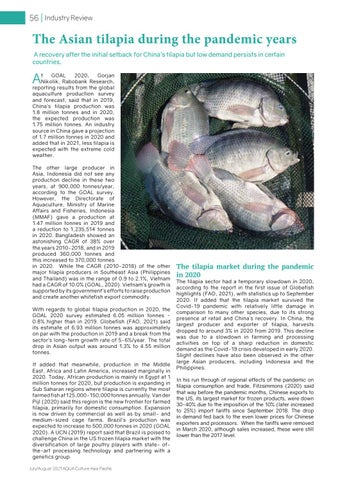56 Industry Review
The Asian tilapia during the pandemic years A recovery after the initial setback for China’s tilapia but low demand persists in certain countries.
A
t GOAL 2020, Gorjan Nikolik, Rabobank Research, reporting results from the global aquaculture production survey and forecast, said that in 2019, China’s tilapia production was 1.8 million tonnes and in 2020, the expected production was 1.75 million tonnes. An industry source in China gave a projection of 1.7 million tonnes in 2020 and added that in 2021, less tilapia is expected with the extreme cold weather. The other large producer in Asia, Indonesia did not see any production decline in these two years, at 900,000 tonnes/year, according to the GOAL survey. However, the Directorate of Aquaculture, Ministry of Marine Affairs and Fisheries, Indonesia (MMAF) gave a production at 1.47 million tonnes in 2019 and a reduction to 1,235,514 tonnes in 2020. Bangladesh showed an astonishing CAGR of 38% over the years 2010-2018, and in 2019 produced 360,000 tonnes and this increased to 370,000 tonnes in 2020. While the CAGR (2010-2018) of the other major tilapia producers in Southeast Asia (Philippines and Thailand) was in the range of 0.9 to 2.1%, Vietnam had a CAGR of 10.0% (GOAL, 2020). Vietnam’s growth is supported by its government’s efforts to raise production and create another whitefish export commodity. With regards to global tilapia production in 2020, the GOAL 2020 survey estimated 6.05 million tonnes 0.8% higher than in 2019. Globefish (FAO, 2021) said its estimate of 6.93 million tonnes was approximately on par with the production in 2019 and a break from the sector’s long-term growth rate of 5-6%/year. The total drop in Asian output was around 1.3% to 4.55 million tonnes. It added that meanwhile, production in the Middle East, Africa and Latin America, increased marginally in 2020. Today, African production is mainly in Egypt at 1 million tonnes for 2020, but production is expanding in Sub Saharan regions where tilapia is currently the most farmed fish at 125,000-150,000 tonnes annually. Van der Pijl (2020) said this region is the new frontier for farmed tilapia, primarily for domestic consumption. Expansion is now driven by commercial as well as by small- and medium-sized cage farms. Brazil’s production was expected to increase to 500,000 tonnes in 2020 (GOAL 2020). A UCN (2019) report said that Brazil is poised to challenge China in the US frozen tilapia market with the diversification of large poultry players with state- ofthe-art processing technology and partnering with a genetics group.
July/August 2021 AQUA Culture Asia Pacific
The tilapia market during the pandemic in 2020
The tilapia sector had a temporary slowdown in 2020, according to the report in the first issue of Globefish highlights (FAO, 2021), with statistics up to September 2020. It added that the tilapia market survived the Covid-19 pandemic with relatively little damage in comparison to many other species, due to its strong presence at retail and China’s recovery. In China, the largest producer and exporter of tilapia, harvests dropped to around 3% in 2020 from 2019. This decline was due to a slowdown in farming and processing activities on top of a sharp reduction in domestic demand as the Covid-19 crisis developed in early 2020. Slight declines have also been observed in the other large Asian producers, including Indonesia and the Philippines. In his run through of regional effects of the pandemic on tilapia consumption and trade, Fitzsimmons (2020) said that way before the pandemic months, Chinese exports to the US, its largest market for frozen products, were down 30-40% due to the imposition of the 10% (later increased to 25%) import tariffs since September 2018. The drop in demand fed back to the even lower prices for Chinese exporters and processors. When the tariffs were removed in March 2020, although sales increased, these were still lower than the 2017 level.













